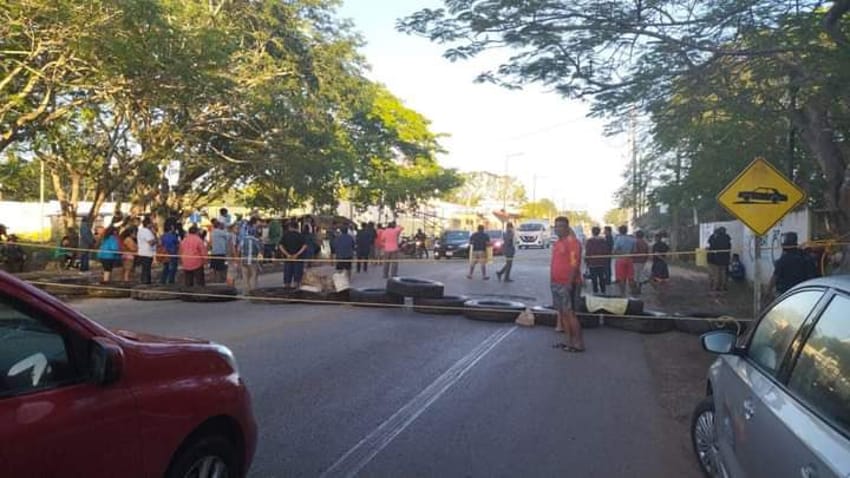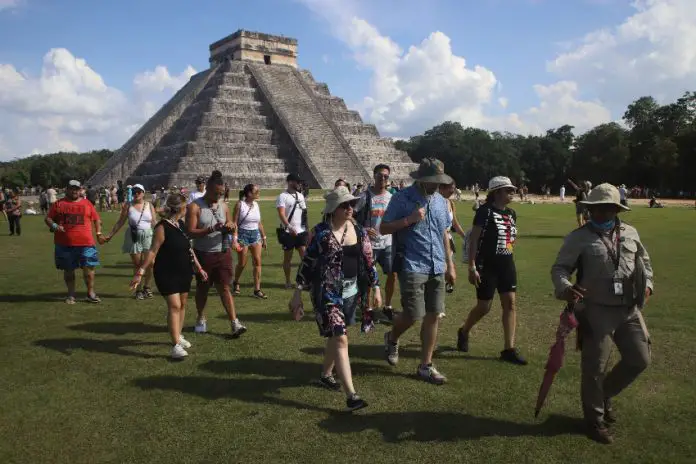After what government officials deemed successful negotiations with leaders, protesters lifted a roadblock Wednesday that had prevented many tourists from reaching the Chichén Itzá archaeological site for 10 days.
The National Institute of Anthropology and History (INAH) issued a statement saying the portion of Highway 180 in Yucatán that leads from Mérida to Mexico’s most-visited archaeological site had been reopened after “necessary agreements and commitments” were achieved at a meeting between the two sides.
However, the groups of ejidatarios, merchants, artisans and activists warned that if their demands are not met in short order, they will resume their protest operations “with more force.”
#ENTÉRATE | Liberan los accesos a la Zona Arqueológica de #ChichénItzá, gracias a los esfuerzos y al trabajo coordinado del @GobiernoMX y en diálogo con las y los manifestantes de Pisté y Xcalacoop. @INAHmx @GobYucatan 👇https://t.co/ff9Qhi7WGc pic.twitter.com/3nGTnywaVF
— Turquesa News (@infoturquesa) January 12, 2023
Video showing protesters removing their blockades on Thursday
The highway to the ancient Maya site had been blocked at two checkpoints.
Though it wasn’t easy to get to, and though officials had begun urging tourists to visit smaller archaeological sites in the area, the Chichén Itzá site had remained open since the Jan. 2 start of the roadblock and protests, which had as many as 10,000 participants, community leaders said.
As recently as Monday, those leaders were saying that no one from INAH or the federal government had come forward to seek a solution.
That all changed “thanks to the efforts made by the national representation of the Ministry of the Interior,” said Arturo Chab Cárdenas, director of the INAH Yucatán Center.
“The government of Mexico has complied with many requests for clarifications from the communities,” he said.
The talks were held at the Municipal Palace in Kaua, Yucatán, a few days after vendors filed a complaint with the Human Rights Commission of Yucatán to air their grievances, which they characterize as violations of their rights as Indigenous peoples.

Members of the Xcalakoop, Pisté and San Felipe communities — which are adjacent to the Chichén Itzá property — said they took to the streets after years of government officials not listening to their claims that INAH has been preventing them from setting up shop near the site’s major structures: the main pyramid, known as El Castillo, and by the popular Temple of Kukulcán.
Tour guides claim they aren’t given customers unless they hand over a percentage of their earnings.
Other protesters included farmers whose property abuts the archaeological zone. They want financial compensation due to not being allowed to plant crops. Others claim that those working on site, many who don’t speak Spanish, are prohibited from speaking Mayan.
Protesters are calling for the removal of INAH’s Chichén Itzá site director Marco Antonio Santos Ramírez. However, the agreement reached on Wednesday does not include the removal of Santos, who has blamed the protests on interest groups allegedly trying to “seize us as a political flag” for their own benefit.
The newspaper La Jornada Maya reported that a memorandum of understanding signed by Andrés Peraza, representative in Yucatán of the federal government, and the leaders of the protesters agrees to provide a solution to the demands of the protesters within a week. The signed document includes a list of those demands, including Santos’ dismissal. Representatives of the protesters also asked INAH “not to mess with the artisans” and to treat them with dignity.
The problems at Chichén Itzá are not new, said Eduardo Paniagua, national president of the Mexican Association of Travel Agencies.
“It’s a problem that’s been going on for many years, and it began when many vendors began to enter the archaeological zone, which is against the law,” he said.
A few years ago, he told La Jornada Maya, when he took a group of Japanese tourists to Chichén Itzá, “they ran into these vendors who yelled at them and did everything to attract their attention; and if they failed to make a sale, they insulted them.”
He said tourists often have more fun visiting other places and that if Chichén Itzá officials don’t get the message soon, travel agents will start promoting visits to nearby archaeological destinations such as Mayapán, Tulum and Cobá.
With reports from La Jornada and Diario de Yucatán
